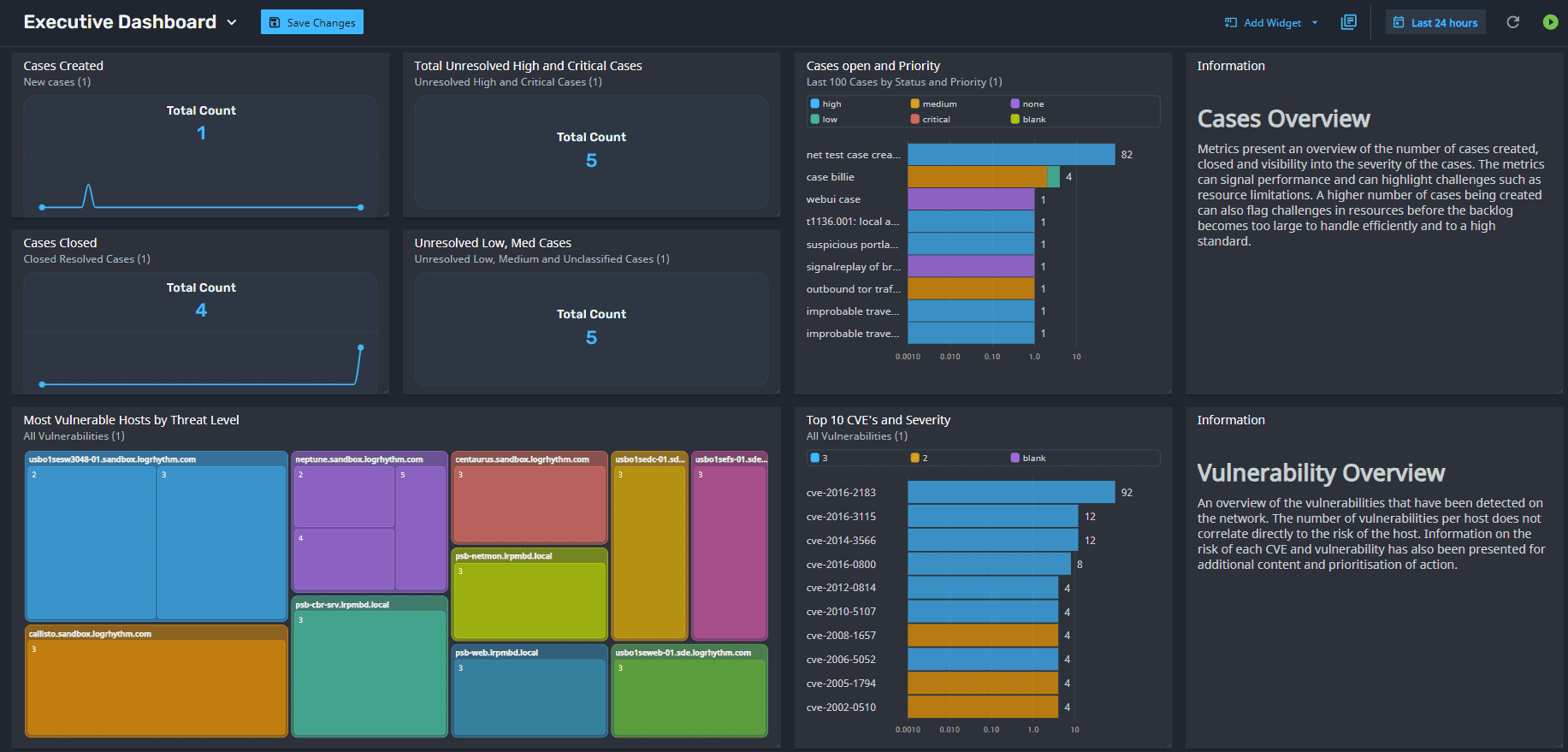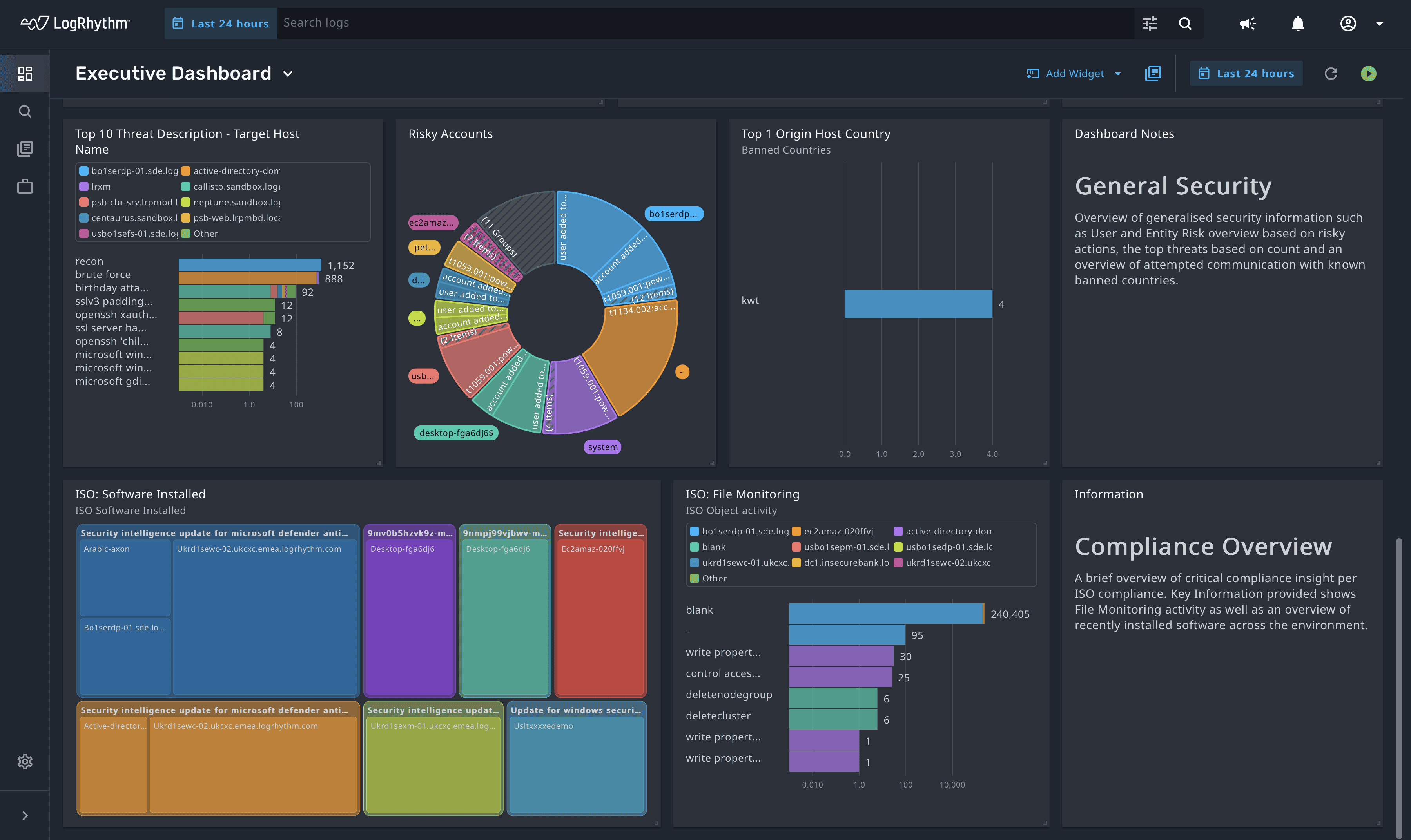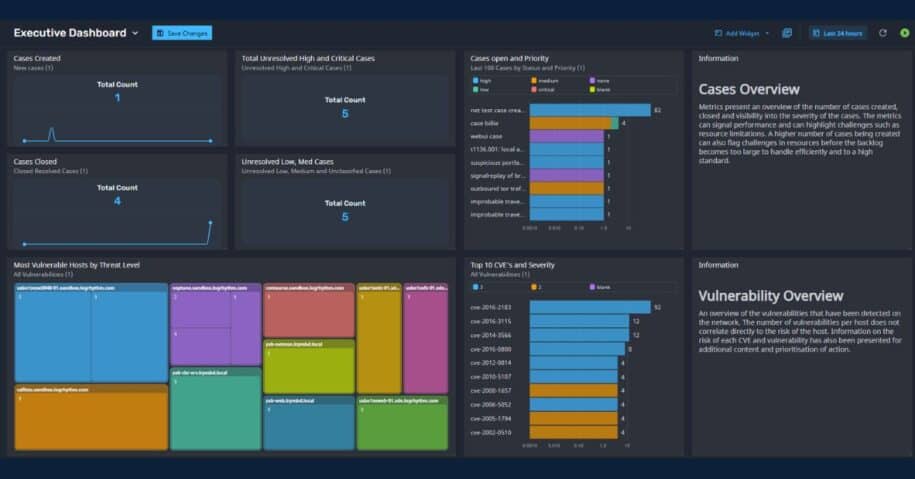Security information and event management (SIEM) platforms aggregate, correlate, and analyze vast amounts of data from across an organization’s environment. With so much information feeding into your system, your SIEM tool should provide insightful reports that highlight pertinent information for the board.
In this blog, we’ll delve into the significance of proving security effectiveness to executive stakeholders and explore how a SIEM cybersecurity board report can empower organizations to make informed decisions in fortifying their defenses.
Understanding Executive Stakeholder Needs
Bridging the gap between the technical intricacies of cybersecurity and the strategic objectives of executives presents a significant challenge. IT and SOC managers often struggle to communicate the effectiveness of security measures in a language that resonates with executive stakeholders. According to LogRhythm’s 2024 State of Security research report:
“Approximately 59% of cybersecurity professionals report challenges in conveying the importance and necessity of particular security measures to executives who may not have a technical background.”
By contextualizing security insights within the broader framework of business impact and strategic goals, you can empower executives to make informed decisions that prioritize cybersecurity without sacrificing operational efficiency or innovation. Your cybersecurity board report should help answer questions executives and board members are about, such as:
- What is the company’s overall risk against a myriad of cyberthreats?
- Is the business compliant with industry regulations to avoid potential legal or financial ramifications?
- How does the company’s security efforts benchmark against industry standards?
- Is the company secure against third-party breaches?
- How can we ensure we have a trusted reputation with partners, customers, and investors?
- What blockers are stopping us from securing the sensitive data and infrastructure effectively?
This is where the importance of aligning SIEM reporting with executive expectations and business objectives emerges. A SIEM report capable of providing high-level, easily digestible information that highlights key risk indicators, emerging threats, and the effectiveness of security controls can bridge the communication gap between security and IT professionals and executive stakeholders.
Leveraging SIEM Reporting for Executive Engagement
Presenting SIEM reports effectively to executive stakeholders requires implementing a few simple strategies.
Focus on Business Impact and Contextualize Technical Metrics
Tailor SIEM reports to highlight the direct impact of security investments on your organization’s bottom line. Emphasize how effective security measures mitigate risks, protect critical data and safeguard customers, and bolster your organization’s reputation, thus contributing to long-term trust and financial stability.
Instead of bombarding executives with technical metrics, contextualize them within the broader framework of business objectives and industry benchmarks. For example, you can “translate” SIEM reporting metrics into business terms for topics like workforce productivity, financial impact, and enhanced regulatory compliance.
Use Visualizations and Executive Summaries
Executive stakeholders often have limited time and may lack sufficient understanding of cybersecurity measures. Use visualizations such as graphs, charts, and dashboards to convey key insights quickly and effectively. Additionally, provide executive summaries that distill complex technical data into high-level, actionable points.
For example, in the SIEM cybersecurity board report below, you can see a summary of a Cases Overview and Vulnerability Overview detailed in the Information widgets. Both of these sections help executives easily understand what the data means and why it is important in terms of the prioritization and productivity.

Map Reporting to Regulatory Compliance
Highlight how SIEM reporting aligns with regulatory requirements and industry standards. Demonstrate compliance with regulations such as GDPR, HIPAA, and PCI DSS to showcase your organization’s commitment to data protection and governance.

Provide Actionable Recommendations
Don’t just tell them what could go wrong; lay out your team’s plan to prevent or fix it. Identifying risks and vulnerabilities isn’t enough. Offer actionable recommendations with prioritized steps for improving security posture, allocating resources, and implementing proactive measures to stay ahead of emerging threats.
Break Down the Return on Investment (ROI)
For many stakeholders, it all comes down to the money. Quantify the ROI of security investments by demonstrating cost savings, risk reduction, and operational efficiencies gained through effective security measures.
By employing these strategies, your cybersecurity board report will demonstrate the value of security investments and initiatives in safeguarding your organization’s assets and achieving its broader business objectives.
Tailoring Communication in Your Cybersecurity Board Report to Resonate with Executive Priorities and Concerns
Effective communication with executive stakeholders is crucial. However, conveying the intricate details of cybersecurity operations to non-technical decision-makers is often challenging. By presenting key information clearly and aligning with executive objectives, organizations can enhance decision-making, improve communication and alignment across stakeholders, identify issues as well as opportunities within the cybersecurity landscape, and foster transparency and accountability in addressing security challenges.
Doing so not only streamlines reporting processes but also empowers executives to make informed decisions that fortify the organization’s security posture and drive strategic initiatives forward.
Enable Enhanced Decision-Making
Elevate decision-making processes by presenting key information in a clear and concise manner. By distilling complex technical data into actionable insights, executives can swiftly identify areas of concern and allocate resources accordingly, leading to more informed and effective strategic decisions.
Keep Communication Simple and Clear
Simplify the presentation of security data to ensure all stakeholders, regardless of their technical expertise, can grasp the organization’s current security position. By fostering clearer communication and alignment across the entire company, your organization can enhance collaboration and ensure everyone is working towards shared security goals.
Paint a Comprehensive Overview
Provide a comprehensive overview of both successes and challenges within the cybersecurity department. Highlight what is working well to celebrate achievements and reinforce effective practices, while also identifying areas for improvement and addressing vulnerabilities proactively. This approach enables executives to make data-driven decisions that drive continuous improvement in security posture.
Encourage Continuous Improvement
Foster a culture of transparency and accountability by openly addressing challenges and vulnerabilities within your organization’s cybersecurity framework. By highlighting these issues in the SIEM board report, you’re able to demonstrate your commitment to addressing them head-on, thereby reducing the risk of overlooking or ignoring critical security concerns. This proactive approach ensures that security challenges are acknowledged and resolved promptly, enhancing overall resilience and risk mitigation efforts.
By incorporating these principles into cybersecurity board reports, organizations can move away from traditional “swivel-chair analytics” towards a more efficient, time-saving, and impactful approach to reporting. This not only streamlines reporting processes but also empowers executives to make well-informed decisions that strengthen the organization’s security posture and protect against emerging threats.
Reporting Cybersecurity to the Board Through SIEM
Those who work in it every day know that the landscape of cybersecurity is ever-changing. The ability to effectively communicate the efficacy of security measures to executive stakeholders is incredibly important.
However, the journey towards security effectiveness doesn’t rest solely on the shoulders of executives. IT and SOC managers play a pivotal role in driving their organization’s security posture through effective communication and reporting. By translating complex technical data into actionable insights and aligning them with executive expectations and business objectives, IT and SOC managers serve as linchpins in their organization’s cybersecurity strategy.
Embracing SIEM reporting is not only a technical necessity, but a powerful tool for achieving broader business goals. By fostering collaboration between technical and executive teams, SIEM reporting can both catalyze innovation and streamline operations. Seize this opportunity to harness the full potential of SIEM reporting in safeguarding your digital future by learning more about LogRhythm Axon — a cloud-native SIEM platform that makes it easy for security teams to do exactly what we’ve described in this blog.
Looking for other ways to measure the success of your security program? This e-Book reveals seven technical metrics to prove the success of your security operations.
